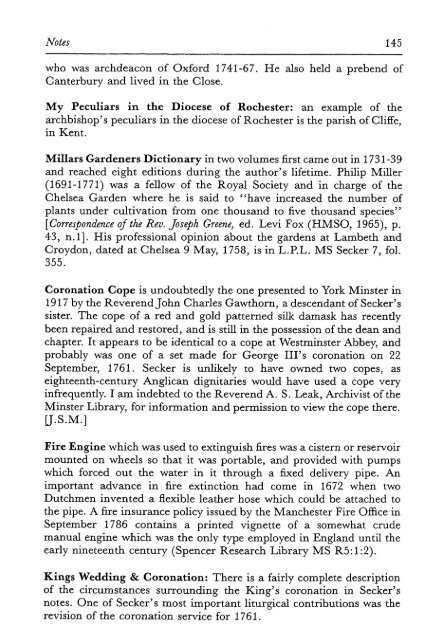Archbishop of Canterbury - KU ScholarWorks - The University of ...
Archbishop of Canterbury - KU ScholarWorks - The University of ...
Archbishop of Canterbury - KU ScholarWorks - The University of ...
Create successful ePaper yourself
Turn your PDF publications into a flip-book with our unique Google optimized e-Paper software.
Notes 145<br />
who was archdeacon <strong>of</strong> Oxford 1741-67. He also held a prebend <strong>of</strong><br />
<strong>Canterbury</strong> and lived in the Close.<br />
My Peculiars in the Diocese <strong>of</strong> Rochester: an example <strong>of</strong> the<br />
archbishop's peculiars in the diocese <strong>of</strong> Rochester is the parish <strong>of</strong> Cliffe,<br />
in Kent.<br />
Millars Gardeners Dictionary in two volumes first came out in 1731-39<br />
and reached eight editions during the author's lifetime. Philip Miller<br />
(1691-1771) was a fellow <strong>of</strong> the Royal Society and in charge <strong>of</strong> the<br />
Chelsea Garden where he is said to "have increased the number <strong>of</strong><br />
plants under cultivation from one thousand to five thousand species"<br />
[Correspondence <strong>of</strong> the Rev. Joseph Greene, ed. Levi Fox (HMSO, 1965). p.<br />
43, n.l]. His pr<strong>of</strong>essional opinion about the gardens at Lambeth and<br />
Croydon, dated at Chelsea 9 May, 1758, is in L.P.L. MS Seeker 7, fol.<br />
355.<br />
Coronation Cope is undoubtedly the one presented to York Minster in<br />
1917 by the Reverend John Charles Gawthorn, a descendant <strong>of</strong> Seeker's<br />
sister. <strong>The</strong> cope <strong>of</strong> a red and gold patterned silk damask has recently<br />
been repaired and restored, and is still in the possession <strong>of</strong> the dean and<br />
chapter. It appears to be identical to a cope at Westminster Abbey, and<br />
probably was one <strong>of</strong> a set made for George Ill's coronation on 22<br />
September, 1761. Seeker is unlikely to have owned two copes, as<br />
eighteenth-century Anglican dignitaries would have used a cope very<br />
infrequently. I am indebted to the Reverend A. S. Leak, Archivist <strong>of</strong> the<br />
Minster Library, for information and permission to view the cope there.<br />
[J.S.M.]<br />
Fire Engine which was used to extinguish fires was a cistern or reservoir<br />
mounted on wheels so that it was portable, and provided with pumps<br />
which forced out the water in it through a fixed delivery pipe. An<br />
important advance in fire extinction had come in 1672 when two<br />
Dutchmen invented a flexible leather hose which could be attached to<br />
the pipe. A fire insurance policy issued by the Manchester Fire Office in<br />
September 1786 contains a printed vignette <strong>of</strong> a somewhat crude<br />
manual engine which was the only type employed in England until the<br />
early nineteenth century (Spencer Research Library MS R5:l:2).<br />
Kings Wedding & Coronation: <strong>The</strong>re is a fairly complete description<br />
<strong>of</strong> the circumstances surrounding the King's coronation in Seeker's<br />
notes. One <strong>of</strong> Seeker's most important liturgical contributions was the<br />
revision <strong>of</strong> the coronation service for 1761.

















